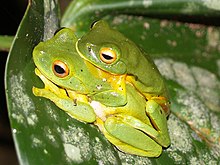ആംപ്ലിക്സസ്

ശരീരത്തിനു പുറത്തുവച്ച് ബീജസങ്കലനം നടത്തുന്ന ചില തവളകളും (ഞണ്ടുകളും) ഇണചേരുന്ന അവസരത്തിൽ ആൺതവളകൾ പെൺതവളകളുടെ പിൻഭാഗത്തു മുറുക്കെ കെട്ടിപ്പിടിക്കുന്നതിനെയാണ് ലാറ്റിൻ ഭാഷയിൽ ആലിംഗനം ചെയ്യുക എന്ന് അർത്ഥമുള്ള ആംപ്ലിക്സസ് (Amplexus) എന്ന പദം കൊണ്ട് വിവക്ഷിക്കുന്നത്. ചിലപ്പോൾ ആ സമയത്തു തന്നെയോ മറ്റു ചിലപ്പോൾ കുറച്ചുസമയത്തിനുശേഷമോ പെൺതവളകളുടെ ശരീരത്തിൽ നിന്നും പുറത്തുവരുന്ന് അണ്ഡവുമായി ബീജസങ്കലനം നടക്കുന്നു. ഉഭയജീവികളിൽ പെണ്ണുങ്ങളുടെ തലയിലോ അരയിലോ കക്ഷത്തിലോ ആണ് കെട്ടിപ്പിടിക്കുന്നത്. ഈ രീതി ജീവശാസ്ത്രനാമകരണത്തിൽപ്പോലും വിവിധസ്പീഷിസുകളെ വേർതിരിക്കാൻ ഉപയോഗിക്കുന്നുണ്ട്. മറ്റു ബാഹ്യബീജസങ്കലനരീതികളിൽ നിന്നും വ്യത്യസ്തമായി ആംപ്ലിക്സസിൽ ആണും പെണ്ണും തമ്മിൽ ശരീരം കൂട്ടിമുട്ടുന്നുണ്ട്. broadcast spawning എന്ന രീതിയിൽ ശരീരം തമ്മിൽ മുട്ടാതെതന്നെ അണ്ഡവും ബീജവും നേരേ വെള്ളത്തിലേക്കു നിക്ഷേപിക്കാറേ ഉള്ളൂ.
ഉഭയജീവികളിൽ
[തിരുത്തുക]


തവളകളിൽ
[തിരുത്തുക]മിക്കവാറും ജലത്തിലാണെങ്കിലും ചില സ്പീഷിസുകളിൽ കരയിൽ വച്ചും ഈ രീതിയിൽ ബീജസങ്കലനം നടക്കുന്നുണ്ട്.[1] മിക്ക തവളകളിലും മുട്ട ഇടുന്ന സമയത്ത് ആൺതവളകൾ അവയ്ക്കു മുകളിൽ ബീജം നിക്ഷേപിക്കാറാണു പതിവ്. Ascaphus എന്ന ജനുസിൽ ഉള്ളിൽ വച്ചാണ് ബീജസങ്കലനം. മറ്റു ചില ജനുസുകളിൽ ഈ രീതി കാണാവുന്നതാണ്.[1][2]
ന്യൂട്ടുകളിൽ
[തിരുത്തുക]മേറ്റിംഗ് സീസൺ തുടങ്ങിയാൽ ഉടൻ തന്നെ ന്യൂട്ടുകളിൽ ഈ രീതി കാണുന്നുണ്ട്.[3]
കുതിരലാട ഞണ്ടുകളിൽ
[തിരുത്തുക]
അരശുഞണ്ടുകളിലെ നാലു സ്പീഷിസുകളിലും ആംപ്ലിക്സസ് നടക്കുന്നുണ്ട്.[4]
മറ്റു ജീവികളിൽ
[തിരുത്തുക]പല ജീവികളും ഈ രീതി അവലംബിച്ചിട്ടുണ്ടാവാമെന്ന് ഫോസിൽ പഠനങ്ങളിൽ കാണുന്നുണ്ട്.[5]
ഇതും കാണുക
[തിരുത്തുക]- Nuptial pad
അവലംബം
[തിരുത്തുക]- ↑ 1.0 1.1 Duellman, W. E. and L. Trueb. 1986.
- ↑ Linzey, D. 2001.
- ↑ C. Michael Hogan (2008) Rough-skinned Newt (Taricha granulosa), Globaltwitcher, ed.
- ↑ Botton, Mark L.; Shuster, Carl N.; Sekiguchi, Koichi; Sugita, Hiroaki (February 1996). "Amplexus and Mating Behavior in the Japanese Horseshoe Crab, Tachypleus tridentatus". Zoological Science. 13 (1): 151–159. doi:10.2108/zsj.13.151.
- ↑ Collette, Joseph H.; Gass, Kenneth C.; Hagadorn, James W. (May 2012). "Protichnites eremita Unshelled? Experimental Model-Based Neoichnology and New Evidence for A Euthycarcinoid Affinity for This Ichnospecies". Journal of Paleontology. 86 (3): 442–454. doi:10.1666/11-056.1.
പുറത്തേക്കുള്ള കണ്ണികൾ
[തിരുത്തുക]- Amplexus in Action Archived 2009-07-03 at the Wayback Machine.
Text is available under the CC BY-SA 4.0 license; additional terms may apply.
Images, videos and audio are available under their respective licenses.
